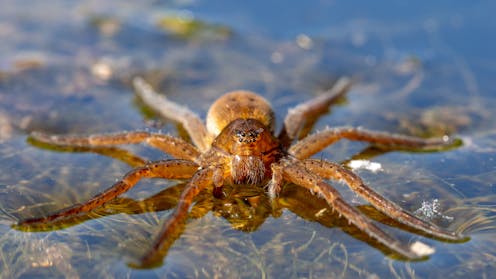Curious Kids: can spiders swim?
- Written by The Conversation

Can spiders swim?
Waubra Preschool students, Victoria, Australia
What a great question!
Most spiders don’t swim by choice. But they sure can survive in water when they need to. From floating like a boat, to paddling like a rower, to carrying their own scuba bubbles, spiders have developed brilliant ways to deal with water.
Let’s dive into the science in some more detail, and look at how spiders handle getting their paws wet, with examples from our local bush.
Spiders can run across water
Water has surface tension – this acts like a kind of invisible skin that can hold up small, light objects.
Many spiders are tiny and have water-repellent hairs on their legs, so they can stand or run on water without sinking.
For example, fishing spiders wait at the water’s edge and scuttle across the surface to grab insects, tadpoles or even small fish.
If prey escapes underwater, this spider can even hide beneath the water’s surface briefly, then come back up.
Spiders can hold their breath underwater for days
Spiders don’t have gills, so they can’t get oxygen from water like fish do. But they have evolved clever strategies for staying alive if they stay in the water for a long time.
For example, the Australian Sydney funnel-web spider often falls into backyard swimming pools. People might see one and think it drowned, but it can actually survive underwater for hours by holding its breath much longer than a human could.
That’s because it breathes much more slowly than we do. Like many spiders, it has both tracheae (tiny air tubes) and book lungs (they look like a book with many pages) for breathing. Some spiders can close these and become watertight, to hold their breath for a long time.
Some trapdoor spiders have been recorded only taking a breath every six minutes.
Do not burst their bubble
Some spiders take the air with them like a scuba diver.
On the Great Barrier Reef coast, a little intertidal spider called Desis bobmarleyi actually lives part of its life under seawater. At high tide, it hides in a silk-lined air pocket in coral or shells. It uses the long hairs on its legs and body to trap a bubble around itself so it can breathe underwater between the tides. When the tide goes out, this spider comes out to hunt on the wet reef.
And in other parts of the world, there’s the famous diving bell spider, the only spider that spends its whole life entirely underwater.
It weaves an underwater silk web that it fills with air – like an underwater house. This spider can stay underwater for more than a day at a time by letting its air-bubble vessel actively pull oxygen from the water.
Flood proofing, trapdoor spider style
Some spiders sit tight and make their homes flood-proof. Remember those trapdoor spiders we mentioned? Trapdoor spiders live snug in burrows underground with a silken lid on top (like a little trapdoor).
In areas that get sudden heavy rains, a trapdoor spider might build its burrow with a raised entrance – a bit like a chimney – so water flows around or over it rather than straight in.
Some Australian trapdoor spiders in the outback clay pans have been found to build thick muddy silk doors that fit perfectly like a bath plug into the surrounding soil. The water just goes straight over the top.
Even if water does get in, some trapdoor spiders can seal their bodies and essentially hold their breath. They don’t swim in their flooded burrows, but they can wait out a flood without drowning.
What to do with a soggy spider
If you ever find a spider struggling in water – say in a swimming pool or even in a bucket – you can help as long as you’re careful.
First, always ask an adult before trying to assist a spider. Nobody has died in Australia in 60 years from spider venom. But some (such as the Sydney funnel-web) can still be fatal, so you must be sure not to touch or provoke it.
A good way to save a spider in a pool is to use a net or a scoop with a long handle. Gently lift the spider out and put it on the ground away from the water. The spider might look dead at first, but don’t be surprised if it “comes back to life” as it dries out – just like trapdoor spiders do.
And remember: never poke a spider with your bare hands, even if it seems lifeless. Spiders such as funnel-webs can still bite underwater or right after being rescued, and they will defend themselves if they feel threatened. So, play it safe and use tools or ask an adult or a spider expert to help.
If anyone is bitten, get an adult to seek medical attention immediately.
Next time you’re exploring nature (or even looking into the toilet), keep an eye out for our eight-legged friends and how they interact with water. You might spot a little spider boat captain or an air-bubble diver right in your backyard.
Read more https://theconversation.com/curious-kids-can-spiders-swim-257832







